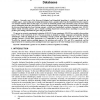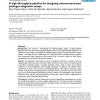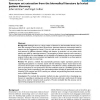BMCBI
2008
13 years 11 months ago
2008
Background: The Codon Adaptation Index (CAI) is a measure of the synonymous codon usage bias for a DNA or RNA sequence. It quantifies the similarity between the synonymous codon u...
BMCBI
2008
13 years 11 months ago
2008
Background: Many programs have been developed to identify transcription factor binding sites. However, most of them are not able to infer two-word motifs with variable spacer leng...
BMCBI
2008
13 years 11 months ago
2008
Background: The number of available genome sequences is increasing, and easy-to-use software that enables efficient comparative analysis is needed. Results: We developed GenomeMat...
BMCBI
2008
13 years 11 months ago
2008
Background: Detailed information about protein interactions is critical for our understanding of the principles governing protein recognition mechanisms. The structures of many pr...
BMCBI
2008
13 years 11 months ago
2008
Currently, most of the discovered biological and biomedical knowledge is available as textual data in scientific papers. And, locating and curating information about a genomic enti...
BMCBI
2008
13 years 11 months ago
2008
Background: The expansion of raw protein sequence databases in the post genomic era and availability of fresh annotated sequences for major localizations particularly motivated us...
BMCBI
2008
13 years 11 months ago
2008
Background: Many proposed statistical measures can efficiently compare protein sequence to further infer protein structure, function and evolutionary information. They share the s...
BMCBI
2008
13 years 11 months ago
2008
Background: We present a methodology for high-throughput design of oligonucleotide fingerprints for microarray-based pathogen diagnostic assays. The oligonucleotide fingerprints, ...
BMCBI
2008
13 years 11 months ago
2008
Background: Although there are a large number of thesauri for the biomedical domain many of them lack coverage in terms and their variant forms. Automatic thesaurus construction b...
BMCBI
2008
13 years 11 months ago
2008
Background: Protein structure analysis and comparison are major challenges in structural bioinformatics. Despite the existence of many tools and algorithms, very few of them have ...



